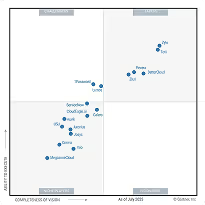HIPAA Compliance Checklist for 2025

Here's the thing: according to Cerby, 77% of organizations are still manually provisioning user access. Yeah, that's real.
In 2025, most IT teams are basically playing access management with spreadsheets and email chains. It's wild.
Think about what that actually looks like. New hire comes in? Someone manually creates their account. They move departments? Manual access updates. They leave? Fingers crossed someone remembers to revoke everything. And that's just the tip of the iceberg.
This is where automated provisioning tools come in. Without them, IT teams are stuck manually creating accounts, updating permissions, and hoping nothing slips through the cracks.
But here's the real talk: not all automated provisioning tools are created equal. Some barely do the basics, while others can actually transform how an entire user access lifecycle works. This guide breaks down which automated provisioning tools actually make sense for different scenarios.
Let's jump in.
TL;DR
- Automated provisioning tools handle user onboarding, role changes, and offboarding automatically, reducing manual effort and errors.
- They improve efficiency, enforce consistent access policies, and lower security and compliance risks.
- Solutions like CloudEagle.ai, Okta, SailPoint, and BetterCloud offer different capabilities for cloud, hybrid, and legacy environments.
- Key benefits include role-based access, app provisioning, license management, workflow automation, and audit-ready records.
- CloudEagle.ai combines HR, IT, and SaaS management in one platform, simplifying the employee lifecycle and improving productivity..
What are Automated Provisioning Tools?
Automated provisioning tools streamline the process of granting user access and setting up infrastructure resources. They automatically create, configure, and manage accounts, systems, and environments, saving time, reducing errors, ensuring consistency, and improving overall operational efficiency.
So what exactly are automated provisioning tools?
They're basically the opposite of what most IT teams are doing right now.
Instead of manually setting up accounts and permissions every single time someone joins, changes roles, or leaves, automated user provisioning handles it automatically.
Here's what happens:
- New person onboards? The system provisions them
- They get promoted? New permissions get provisioned
- They leave? Everything gets deprovisioned
- No manual clicking required
Real provisioning software integrates with an entire tech stack, cloud apps, on-premise systems, everything. It orchestrates workflows so IT teams don't have to be involved in every single step.
The Numbers That Matter:
- 60% reduction in onboarding time.
- 40% decrease in access-related security incidents.
- Organizations see this because the system is consistent in ways manual processes never are.
Why Automated Provisioning Software is Important?
Well, to put this simply. Automated provisioning enhances efficiency, security, and cost savings by replacing manual user access management. It simplifies onboarding and offboarding, enforces consistent policies, reduces errors, and allows IT teams to focus on strategic work.
Excessive Access Permissions Expand Security Risk
When IT teams manually provision access, new employees receive far more permissions than needed. Nobody goes back to clean it up, creating an expanded attack surface.
Research shows that 40% of security breaches involve users with excessive access that manual provisioning software has never caught.
Why this matters:
- New employees get 3-5x more access than their role requires
- One compromised account can infiltrate multiple systems across the organization
- Regulatory bodies consistently flag over-provisioning as a critical compliance gap
Accumulated Permissions Lead to Unmanaged Access Creep
An employee gets promoted or moves departments, new permissions get added, but old ones never get removed.
Six months later, they have access to systems from three departments they no longer work in.
Why this matters:
- An average employee accumulates 15-20+ unnecessary permissions over just 3 years
- 30-40% of active access in most organizations is unnecessary and forgotten
- Old permissions become entry points for attackers during lateral movement
- Organizations using automated provisioning reduce access creep incidents by 55-60%
Inactive Employee Accounts Remain Security Vulnerabilities
When an employee leaves, HR sends an email to IT, but it gets buried. The account stays active indefinitely, becoming a perfect entry point for attackers.
According to a report by CrowdStrike, 45% of data breaches involve compromised employee or contractor accounts, with an average detection time of 243 days.
Why this matters:
- 45% of data breaches involve dormant or orphaned accounts
- Attackers use stale accounts to move laterally without triggering detection
- The average time to detect these breaches is 243 days, plenty of time for damage
Fragmented Access Request Workflows
An employee needs access to a new system, emails their manager or IT, and that request sits in someone's inbox with hundreds of others.
Critical requests get mixed with routine ones with no centralized view.
Why this matters:
- 72% of organizations report that access delays directly slow project delivery
- New employees stay unproductive for an extra 2-3 weeks waiting for access
- IT teams waste over 200 hours annually per person on manual processing
Top 10 Automated Provisioning Tools to Try
1. CloudEagle.ai
CloudEagle.ai is an all-in-one platform that unifies HR, IT, and SaaS management to automate the entire employee lifecycle, onboarding & offboarding. It goes beyond traditional HR systems that rely on manual checklists by providing end-to-end automation for app provisioning, role-based access, and secure de-provisioning.
Whether you’re scaling a fast-growing startup or managing hundreds of SaaS tools in an enterprise, CloudEagle helps eliminate shadow IT, reduce operational overhead, and ensure every employee gets the right access at the right time.
Features
- Automated app provisioning across all SaaS tools
- Role-based access assignment to prevent over-provisioning
- Automatic license and account de-provisioning at offboarding
- Centralized dashboard for IT, HR, and compliance teams
- Integration with HRIS, payroll, and collaboration platforms
- Real-time monitoring of onboarding and offboarding status
- Workflow automation to cut down on manual IT tickets
Benefits
- Ensures new hires are productive on day one with instant app access
- Reduces security risks by revoking ex-employee accounts on time
- Saves HR and IT hours by eliminating manual onboarding tasks
- Enhances compliance with automated audit-ready records
- Simplifies SaaS license management while reducing costs
Pricing CloudEagle.ai offers customized pricing based on company size and SaaS ecosystem. Businesses can request a demo to explore tailored plans.
“Offboarding employees across 100+ SaaS apps used to be a major challenge for our IT team. Manual steps left ex-employees with lingering access, creating security risks and wasted license costs. With CloudEagle.ai’s Zero-Touch Offboarding feature, we’ve closed those gaps. No ex-employee access, lower risks, big cost savings, and simpler compliance.”
— Devon Murphy, Senior Accounting Manager, RecRoom
2. SolarWinds
SolarWinds delivers enterprise-grade automated provisioning tools designed for complex hybrid environments where on-premise, cloud, and virtual systems all need to work together. This provisioning software brings decades of infrastructure expertise into a unified solution.

Features
- Intelligent provisioning that learns from historical access patterns
- Multi-system support (on-premise, cloud, hybrid)
- Advanced workflow automation with conditional logic
- Automated role-based access controls with segregation of duties
- Comprehensive audit trails for regulatory compliance
Limitations
- Higher implementation complexity for organizations new to automated provisioning tools
- Steep learning curve for IT teams unfamiliar with advanced provisioning concepts
- Requires dedicated resources for ongoing management and optimization
- Higher cost compared to entry-level provisioning software solutions
Pricing: SolarWinds uses a perpetual license model starting at approximately $5,000-$15,000 annually for small deployments, scaling to $50,000+ for enterprise environments.
3. JumpCloud
JumpCloud makes automated provisioning tools straightforward and accessible by building simplicity into its provisioning software from the ground up. This solution was built for cloud and hybrid environments where complexity gets in the way.
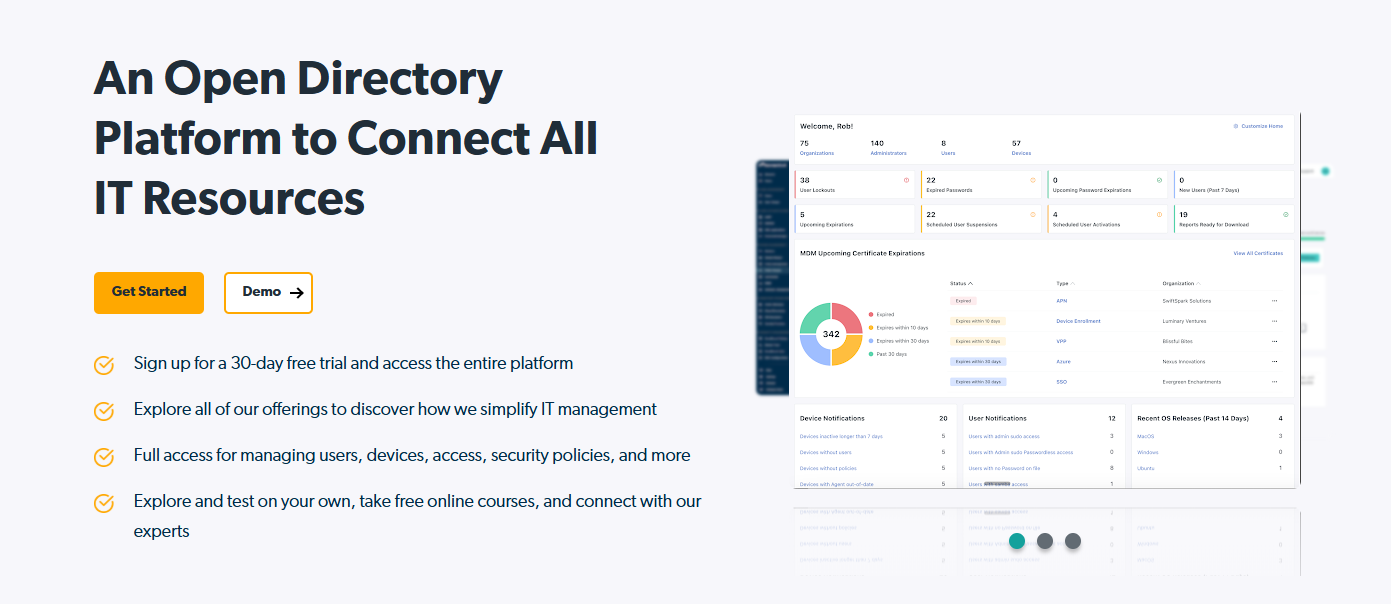
Features
- Simple setup with minimal configuration required
- Support for Windows, macOS, and Linux systems
- Conditional provisioning with time-based access expiration
- Integration with 150+ SaaS applications and systems
- Real-time access verification and monitoring
Limitations
- May lack advanced features needed by very large enterprises
- Customization options are more limited compared to enterprise solutions
- Better suited for mid-market organizations than Fortune 500 deployments
- Integration with legacy systems can be more challenging
Pricing: JumpCloud uses per-user pricing starting at approximately $15-$25 per user/month, depending on features included.
4. SailPoint Identity IQ
SailPoint IdentityIQ is an enterprise-grade automated provisioning tool that streamlines user onboarding, access management, and compliance. Trusted by global organizations, this provisioning software simplifies automated user provisioning across complex systems.

Features
- Lifecycle provisioning that adapts based on employment stage
- Deep integration with identity governance workflows
- Advanced role hierarchy management and conflict detection
- Segregation of duties enforcement during provisioning
- Comprehensive audit trails meeting SOC 2, HIPAA, and PCI-DSS standards
Limitations
- Significant implementation timeline for enterprise deployments (3-6 months)
- Requires dedicated identity governance expertise to maximize value
- Higher cost reflects enterprise-grade capabilities
- Overkill for organizations with simple, straightforward access needs
Pricing: SailPoint uses subscription-based licensing at approximately $50,000-$150,000+ annually, depending on deployment size and complexity.
5. Okta
Okta is a leading automated provisioning tool for cloud-first organizations, offering seamless automated user provisioning across modern SaaS apps. Its robust SCIM integrations make this provisioning software fast, reliable, and easy to scale across your entire application stack.

Features
- Industry-leading SCIM integration with 500+ SaaS applications
- Fast and reliable provisioning engine designed for cloud apps
- Security-first approach with automatic logging of all provisioning actions
- Developer-friendly API for custom automated provisioning workflows
- Real-time sync between identity and application access
Limitations
- Less ideal for organizations with significant on-premise infrastructure
- Legacy system integration can be more complex than cloud apps
- May require additional tools for comprehensive access governance
- SCIM support varies across older enterprise applications
Pricing: Okta uses per-active-user pricing starting at approximately $2-$8 per user/month, depending on subscription tier.
6. Google Cloud Platform
Google Cloud offers built-in automated provisioning tools through its Cloud Identity service, enabling seamless automated user provisioning within your cloud infrastructure. Instead of standalone provisioning software, it delivers native, integrated access management for organizations running entirely on Google Cloud.
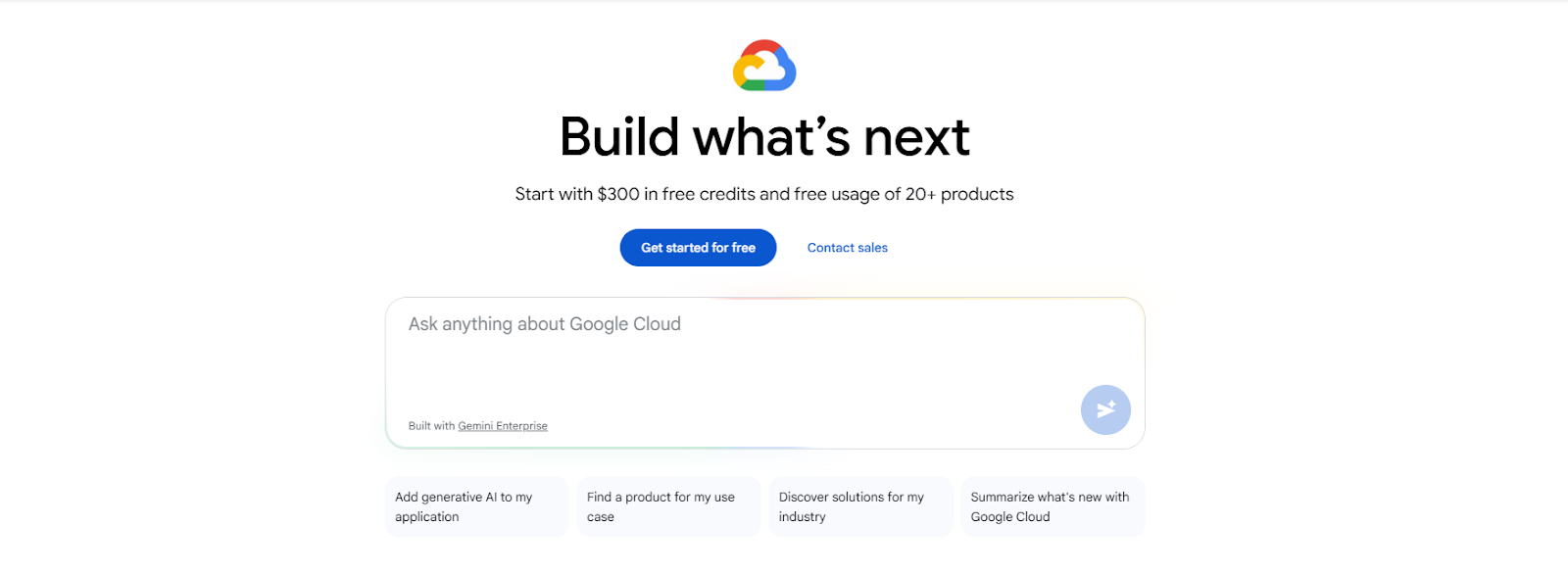
Features
- Native integration with Google Cloud infrastructure and services
- Instant access propagation to compute, storage, and application layers
- Role-based access control deeply integrated with GCP services
- Automated provisioning for Google Workspace and Cloud resources
- Real-time synchronization between identity and resource access
Limitations
- Less flexible for organizations with multi-cloud strategies
- On-premise system integration requires additional tooling
- Best suited for organizations primarily using Google services
- May require workarounds for non-Google legacy systems
Pricing: Google Cloud Identity Standard is free for up to 50 users. Identity Premium pricing starts at approximately $4-$10 per user/month.
7. VMware by Broadcom
VMware by Broadcom offers automated provisioning tools tailored for virtualized environments. This provisioning software manages access across vSphere, virtual desktops, and apps natively, delivering seamless automated user provisioning for VMware-centric infrastructures.
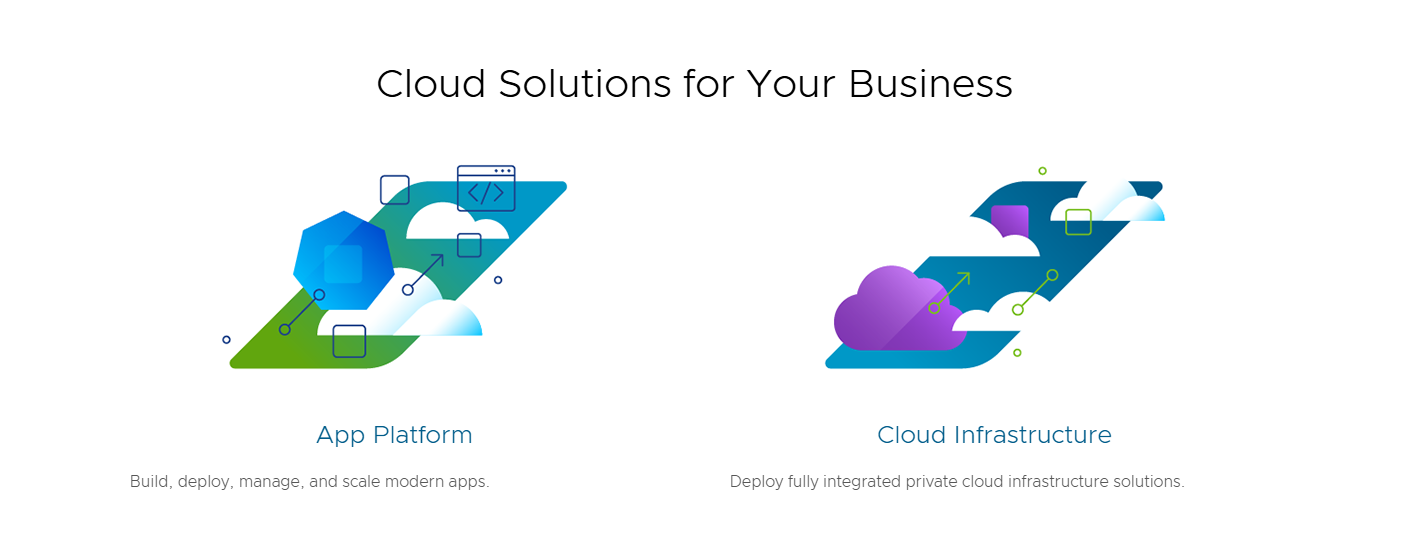
Features
- Native support for vSphere, Horizon, and virtualized infrastructure
- Provisioning for virtual machines, storage, and compute resources
- Integration with VMware automation and orchestration tools
- Role-based access controls designed for virtualized environments
- Real-time monitoring of provisioning status across the virtual infrastructure
Limitations
- Best suited for organizations with significant VMware infrastructure
- It may be unnecessarily complex for organizations without virtualization
- Limited value for purely cloud-native organizations
- Integration with non-VMware systems can be challenging
Pricing: VMware pricing is part of Broadcom's licensing model, typically ranging from $10,000-$50,000+ annually, depending on infrastructure size.
8. AWS CloudWatch
While AWS CloudWatch isn’t a standalone provisioning software, AWS integrates automated provisioning tools across its identity ecosystem. Through IAM and configuration management, teams can enable flexible automated user provisioning with granular, infrastructure-as-code access control.

Features
- IAM-based provisioning integrated with AWS services
- Resource-level, service-level, and application-level provisioning options
- Cross-account provisioning across AWS organizations
- Real-time audit logging through AWS CloudTrail
- Infrastructure-as-code support for provisioning workflows
Limitations
- Requires significant technical expertise to configure properly
- Less suitable for organizations prioritizing simplicity over customization
- Multi-cloud strategies require additional tooling beyond AWS
- On-premise provisioning requires integration with external tools
Pricing: AWS provisioning is included in IAM, which is free for the first 12 months. After that, standard IAM pricing applies, approximately $0.02-$0.10 per million API requests.
9. Oracle Access Management
Oracle Access Management delivers enterprise-grade automated provisioning tools backed by decades of identity expertise. This provisioning software supports both legacy and cloud environments, offering robust automated user provisioning tailored to complex enterprise needs.

Features
- Support for Oracle databases, ERP systems, and legacy enterprise applications
- Complex role hierarchy management with conflict detection
- Segregation of duties enforcement throughout the provisioning process
- Advanced workflow automation for intricate provisioning scenarios
- Comprehensive audit trails meeting enterprise compliance standards
Limitations
- Higher implementation complexity for organizations new to Oracle solutions
- Best suited for organizations already invested in Oracle infrastructure
- It may be overkill for smaller organizations with simpler needs
- Steeper pricing reflects enterprise-grade capabilities and support
Pricing: Oracle Access Management pricing starts at approximately $30,000-$100,000+ annually, depending on deployment scope.
10. BetterCloud
BetterCloud offers SaaS-first automated provisioning tools designed for cloud-native organizations. This provisioning software streamlines access across multiple SaaS apps, providing seamless automated user provisioning for both onboarding and offboarding.
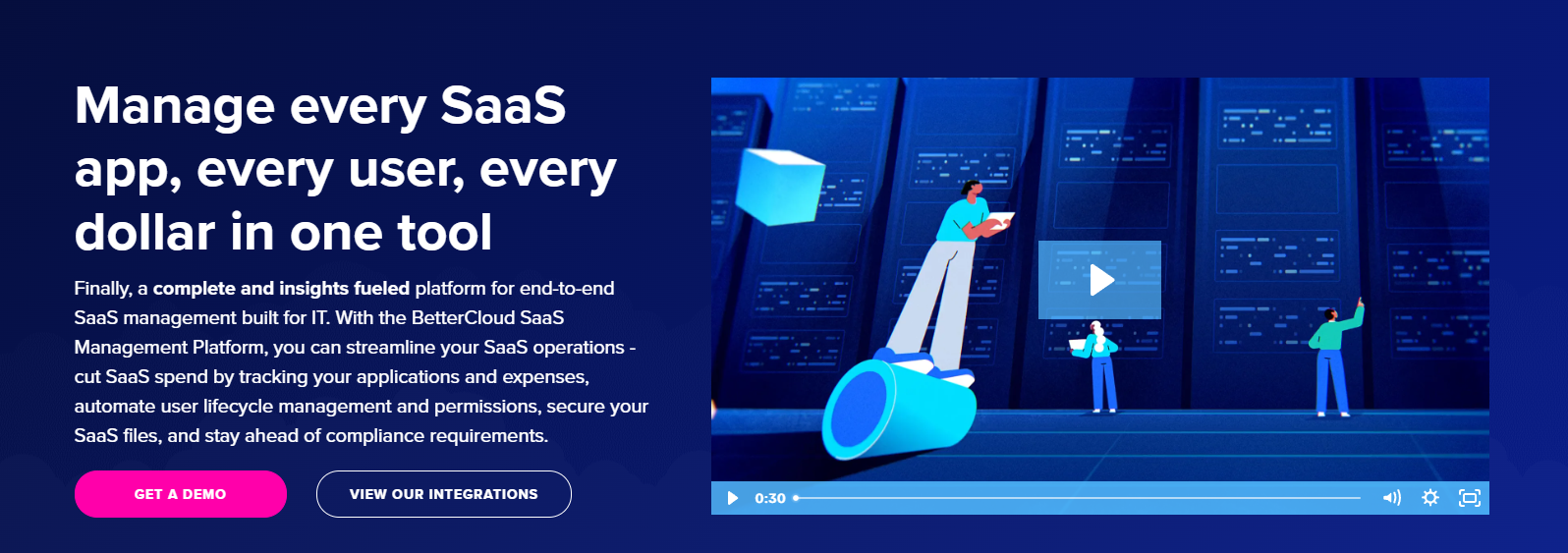
Features
- Simultaneous provisioning across 50+ SaaS applications
- Real-time sync between identity and app access
- Conditional provisioning based on role, department, or custom attributes
- Automated offboarding with complete access revocation
- Detailed audit trails for compliance and forensics
Limitations
- Best suited for SaaS-heavy organizations
- Less ideal for organizations with significant on-premise infrastructure
- Limited capabilities for managing non-cloud access
- May require additional tools for comprehensive identity governance
Pricing: BetterCloud uses per-user pricing starting at approximately $10-$30 per user/month, depending on features and SaaS app count.
Final Thoughts
Automated provisioning tools make IT life easier by handling onboarding, role changes, and offboarding automatically. They reduce manual work, limit errors, and make sure employees have the right access when they need it, without relying on spreadsheets or long email chains.
CloudEagle.ai combines HR, IT, and SaaS management in one platform. It automates app provisioning, assigns role-based access, and deactivates accounts and licenses at offboarding. With real-time monitoring, workflow automation, and integrations with HRIS, payroll, and collaboration tools, it keeps the employee lifecycle smooth and organized.
To see how it can save time and reduce mistakes in your organization, book a free demo of CloudEagle.ai today.
Frequently Asked Questions
- What is automatic provisioning?
Automatic provisioning is the process of creating, updating, and removing user accounts and permissions automatically, ensuring the right access at the right time without manual intervention. - What are some examples of automation tools?
Examples include CloudEagle.ai, Okta, SailPoint, BetterCloud, JumpCloud, and VMware, tools that streamline user access, app provisioning, and lifecycle management. - What is the main benefit of automated provisioning in DevOps?
It speeds up onboarding, ensures consistent access, reduces errors, and allows DevOps teams to focus on development rather than manual account management. - Which automation tool is best?
The best tool depends on your environment; CloudEagle.ai is ideal for HR, IT, and SaaS integration, while Okta, SailPoint, and BetterCloud suit cloud or enterprise-focused needs. - What is the future of provisioning?
Provisioning will become more intelligent, integrated, and automated, leveraging AI and real-time monitoring to manage access efficiently across cloud, hybrid, and legacy systems.

%201.svg)









.avif)




.avif)
.avif)




.png)
